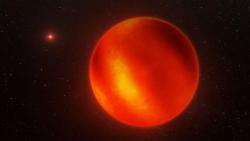Brown Dwarfs Display Extreme Weather, Webb Telescope Reveals
Webb telescope uncovers extraordinary weather patterns on cosmic brown dwarfs

Scientists utilized the James Webb Space Telescope to perform detailed analyses of the atmospheric conditions on brown dwarfs, particularly a pair orbiting each other around six light years away from Earth, a relatively short distance by cosmic standards. To put it into perspective, a light-year is the distance light travels in one year, which is 9.5 trillion km.
The data from Webb offered a three-dimensional view of weather changes over the course of a brown dwarf’s rotation – with the larger one taking seven hours and the smaller one taking five hours. Multiple cloud layers were identified at various atmospheric depths.
These brown dwarfs have atmospheres primarily composed of hydrogen and helium, with small amounts of water vapor, methane, and carbon monoxide. The temperature at their cloud tops is approximately 925 degrees Celsius, akin to the heat of a candle flame.
"In this study, we created the most detailed 'weather maps' for any brown dwarf to date," said astronomer Beth Biller from the University of Edinburgh's Institute for Astronomy, the lead author of the study featured in the scientific journal Monthly Notices of the Royal Astronomical Society.
Brown dwarfs are intermediate between stars and planets. They emit light due to their intense heat – "just like you would see embers in a fire glowing red because of how hot they are," Biller explained. The researchers observed this very light using the Webb Telescope. Unlike stars, brown dwarfs do not undergo nuclear fusion at their core.
"Like planets, but unlike stars, brown dwarfs can also have clouds made out of precipitates in their atmospheres. However, while we have water clouds on Earth, the clouds on brown dwarfs are much hotter and likely made up of hot silicate particles – kind of like a very hot Saharan dust storm," Biller noted.
Current scientific understanding suggests that brown dwarfs form from large clouds of gas and dust similarly to stars but lack the mass required to initiate nuclear fusion. Their composition resembles that of gas giant planets like Jupiter, the largest planet in our solar system. They can be up to 80 times more massive than Jupiter. For context, the sun’s mass is about 1,000 times that of Jupiter.
The two brown dwarfs observed by Webb were formed approximately 500 million years ago. Each has a diameter comparable to Jupiter’s. One has a mass 35 times that of Jupiter, and the other is 30 times more massive.
Webb's observations revealed variations in their light as different atmospheric features came into view during their rotations.
"The fast rotation of both objects helps to drive their weather patterns, and if you could actually directly see the cloud-top structure, you probably would be able to see bands and vortices, like the Great Red Spot, as you do on Jupiter," Biller said.
"In the future, similar techniques could be used to study weather on potentially habitable exoplanets," Biller added, referring to planets outside our solar system.
Brown dwarfs are somewhat common in the cosmos. Around 1,000 have been identified, compared to over 5,000 known exoplanets.
The Webb Telescope primarily observes the universe in the infrared spectrum, while its predecessor, the Hubble Space Telescope, operates mainly at optical and ultraviolet wavelengths.
"The atmospheres of brown dwarfs are highly complex. Webb provides a huge leap forward in our ability to understand these atmospheres by providing unprecedented wavelength range and sensitivity," said Johanna Vos, an astronomer from Trinity College Dublin in Ireland and a co-author of the study.
"These different wavelengths allow us to monitor the atmosphere from very deep to very shallow, giving a comprehensive look at the full extent of the atmosphere," Vos concluded.
Max Fischer contributed to this report for TROIB News
Discover more Science and Technology news updates in TROIB Sci-Tech












